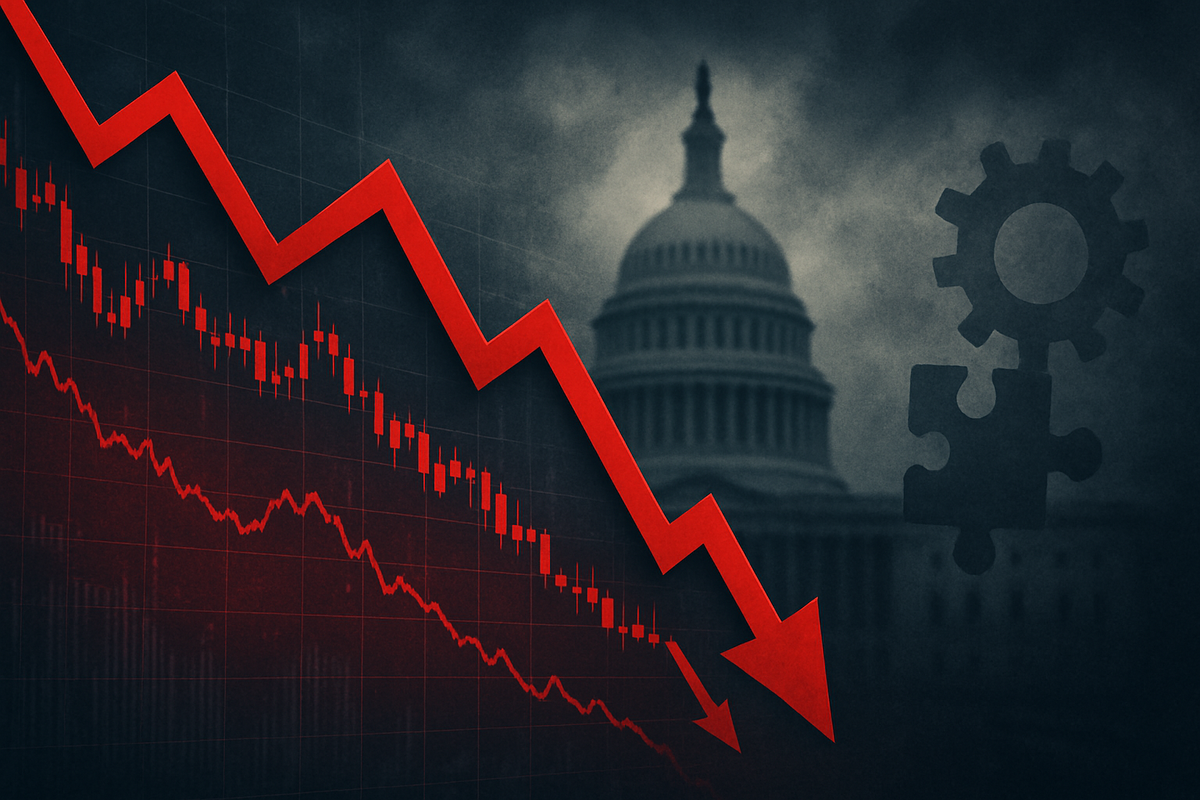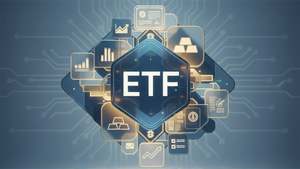
The U.S. stock market has been navigating a turbulent period, marked by a noticeable slide in major indices as the nation grapples with the dual pressures of an impending government shutdown and a stream of unexpectedly weak jobs data. As of October 1, 2025, investor confidence remains fragile, with concerns mounting over economic stability and the Federal Reserve's (Fed) future monetary policy decisions. This confluence of political gridlock and economic fragility has cast a pall over equities, prompting a shift towards safe-haven assets and heightening overall market volatility.
The immediate implications are clear: increased uncertainty, a potential slowdown in economic activity, and a complicated outlook for corporate earnings. Market participants are closely watching developments in Washington D.C. and scrutinizing every economic indicator, seeking clarity in an environment clouded by both political brinkmanship and signs of a faltering labor market. The current climate suggests that the path forward for investors will be fraught with challenges, demanding careful consideration and strategic adjustments.
A Perfect Storm: Political Deadlock Meets Economic Headwinds
The recent market downturn is a culmination of several impactful events, creating a challenging landscape for investors. While the immediate concerns revolve around the government's fiscal year-end, the market had already absorbed a significant shock earlier in the year.
In April 2025, the global stock market experienced a sharp crash between April 2 and April 10, primarily triggered by new sweeping tariff policies. On April 2, S&P 500 futures plummeted 3.9%, Nasdaq-100 futures fell 4.7%, and Dow Jones Industrial Average futures dropped 2.7%. The following day, April 3, the Nasdaq Composite suffered a substantial loss of 1,600 points, the S&P 500 fell 4.84%, and the Dow Jones Industrial Average dropped 1,679 points (3.98%). The Russell 2000 led losses, entering a bear market with a 6.59% decline. The sell-off continued on April 4, with the Dow falling another 2,231 points (5.5%). In just two days, over $6.6 trillion was wiped out, and the Chicago Board Options Exchange's VIX (fear gauge) spiked to 45.31 points, its highest close since the 2020 crash. This earlier volatility set a precedent for investor nervousness.
Fast forward to September 2025, and the market found itself under renewed pressure. Fears of a U.S. government shutdown intensified significantly as Congress failed to reach an agreement on funding bills before the October 1st fiscal year deadline. The primary sticking point reportedly involved Democrats insisting on extending Affordable Care Act tax credits, which Republicans opposed. Investors grew concerned that a shutdown would delay crucial economic reports, such as the September jobs report and mid-October inflation data, leaving the Federal Reserve and financial markets "in the dark" regarding the economy's true state.
Compounding these political anxieties was a series of weak jobs data reports. On September 9, 2025, the Bureau of Labor Statistics (BLS) announced a preliminary annual revision, significantly reducing job growth estimates for the 12 months ending March 2025 by 911,000 jobs, indicating a much weaker labor market than previously understood. The August 2025 Jobs Report, released in early September, showed a paltry addition of only 22,000 jobs, far below economists' estimates, and the unemployment rate rose to 4.3%, its highest since October 2021. This report heavily influenced the Fed's decision to cut interest rates at its subsequent meeting. On September 30, 2025, U.S. stocks experienced slight declines, with the Dow Jones (DJIA) dropping approximately 0.4%, and the S&P 500 (SPX) and Nasdaq Composite (IXIC) each slipping around 0.3%. Finally, on October 1, 2025, as the government shutdown loomed, the ADP National Employment Report for September revealed an unexpected fall of 32,000 private-sector jobs, contrasting sharply with expectations for an increase. This ADP report gained heightened importance due to the anticipated delay of the official BLS jobs report caused by the shutdown. Upon market open, U.S. stocks continued to slide, with the S&P 500 dropping 0.30%, the Dow falling 0.12%, and the Nasdaq Composite declining 0.31%. Reflecting increased safe-haven demand, gold prices surged from around $3,800 to over $3,870 per ounce between September 29 and October 1, while the U.S. dollar weakened.
Companies on the Brink: Winners and Losers in a Shifting Landscape
The current economic and political environment presents a mixed bag for public companies, with some facing significant headwinds and others potentially finding opportunities amidst the turmoil.
Companies heavily reliant on government contracts are poised to be immediate losers. During a shutdown, these firms could face delayed or reduced payments, impacting their cash flow and project timelines. This includes a wide array of defense contractors, IT service providers for government agencies, and infrastructure companies. Small and medium-sized businesses (SMBs) are also particularly vulnerable, as highlighted by the negative ADP jobs report, which showed job losses concentrated in this segment. These businesses often lack the financial reserves to withstand prolonged disruptions in demand or payment.
Furthermore, sectors sensitive to consumer confidence and spending are likely to suffer. The slowdown in the labor market, partly attributed to trade tariffs and the adoption of artificial intelligence, is expected to impact industries such as transportation and warehousing. Airlines like American Airlines (NASDAQ: AAL) and logistics giants such as United Parcel Service (NYSE: UPS) could see reduced demand for travel and shipping if economic activity falters and consumer spending tightens. Similarly, professional services, information, and creative industries, including major media and entertainment companies like The Walt Disney Company (NYSE: DIS), Sony Group Corporation (NYSE: SONY), Warner Bros. Discovery (NASDAQ: WBD), and Netflix, Inc. (NASDAQ: NFLX), could face challenges due to job losses, reduced advertising budgets, and a general tightening of discretionary spending. Furloughed federal workers, even if eventually receiving back pay, face immediate financial stress from missed paychecks, which directly impacts consumer spending.
Conversely, in times of market uncertainty, safe-haven assets tend to perform well. The surge in gold prices indicates that companies involved in gold mining or related exchange-traded funds (ETFs) could see increased investor interest. Defensive sectors, such as utilities and consumer staples, which are less sensitive to economic cycles, might also offer relative stability. However, the overall sentiment is one of caution, with more companies likely to face challenges than to find clear-cut advantages in the immediate term.
Broader Implications: A Tenuous Economic Outlook
The intertwining of government shutdown fears and weak jobs data carries wider significance, threatening to exacerbate existing economic fragilities and complicate the Federal Reserve's policy path. This event fits into a broader trend of economic uncertainty that has been characterized by persistent inflation, fluctuating interest rates, and a global economy still finding its footing.
Analysts at Nomura estimate that a government shutdown could reduce economic growth by 0.1 to 0.2 percentage points for each week it lasts, with a similar positive effect on growth in the quarter following its resolution. Goldman Sachs economists similarly projected a reduction of about 0.15 percentage points of Q4 GDP growth per week of shutdown. These projections highlight the tangible impact a shutdown can have on an economy already showing "red flags" and "shaky" indicators. The U.S. economy was already contending with persistent inflation, making any further disruption particularly unwelcome.
The ripple effects extend beyond GDP numbers. A prolonged shutdown erodes consumer confidence, leading to reduced economic activity. The uncertainty surrounding federal worker paychecks and the potential for delayed government services can make households and businesses hesitant to spend or invest. This can create a vicious cycle, further dampening demand and job creation. The Federal Reserve also faces a significant challenge. While the weak labor market data increased the likelihood of further interest rate cuts—the Fed had already cut rates in September, with strong expectations for additional cuts in October—the delay of crucial economic data due to a shutdown could severely complicate the Fed's ability to make informed policy decisions. Operating in the dark, the Fed might struggle to accurately assess the economy's health and implement appropriate monetary policy, potentially leading to less effective interventions.
Historically, government shutdowns have often caused short-term market volatility rather than lasting damage. However, analysts warn that the current economic climate, already weaker than usual, could make this shutdown more disruptive. The duration of any shutdown is deemed a critical factor in determining its ultimate economic impact, with longer shutdowns posing a greater risk of systemic damage.
What Comes Next: Navigating the Fog of Uncertainty
Looking ahead, the market faces a period of heightened uncertainty, with both short-term volatility and long-term economic shifts on the horizon. The immediate future will largely hinge on the resolution of the government shutdown and the subsequent release of delayed economic data.
In the short term, investors should brace for continued market volatility. Any news regarding progress (or lack thereof) in congressional negotiations will likely trigger immediate market reactions. Should a shutdown be prolonged, the negative impact on GDP growth and consumer confidence will intensify, potentially leading to further market declines. Conversely, a swift resolution could spark a relief rally, though the underlying economic weaknesses revealed by the jobs data will persist. The Federal Reserve's next moves will be closely watched; without clear data, their decisions on interest rates become more speculative, adding another layer of unpredictability.
From a long-term perspective, businesses may need to consider strategic pivots or adaptations. Companies with significant government exposure might explore diversifying their client base or building stronger financial reserves to weather future political impasses. Industries reliant on consumer spending will need to be agile in responding to shifts in demand, potentially focusing on cost efficiencies and value propositions. For investors, this environment presents both challenges and potential opportunities. While the immediate outlook is challenging, periods of market stress can uncover undervalued assets for those with a long-term horizon and a robust risk management strategy.
Potential scenarios range from a relatively quick resolution that allows the market to stabilize, albeit with lingering concerns about economic growth, to a protracted shutdown that pushes the economy closer to a recession. In the latter scenario, we could see more significant job losses, a further erosion of consumer confidence, and a more aggressive stance from the Federal Reserve to stimulate the economy. The emergence of clear market opportunities will likely depend on the clarity that emerges from the political sphere and the subsequent economic data, allowing for a more accurate assessment of the fundamental health of public companies.
A Comprehensive Wrap-up: Watching for Clarity
The recent slides in the stock market underscore a critical juncture for the U.S. economy, where political gridlock and economic fragility have converged to create a challenging investment landscape. The key takeaways from this period are the profound impact of government shutdown fears on market sentiment and the undeniable evidence of a weakening labor market, both of which are significantly influencing Federal Reserve policy expectations.
Moving forward, the market will remain in a state of flux, heavily influenced by developments in Washington D.C. and the release of crucial economic data. The duration and resolution of any government shutdown will be paramount in determining the immediate trajectory of the economy and financial markets. A swift and amicable resolution could provide a much-needed boost to investor confidence, while a prolonged impasse risks deepening economic wounds.
The lasting impact of these events will depend on how quickly the economy can regain momentum and how effectively policymakers can address both fiscal stability and labor market health. What investors should watch for in the coming months includes any progress on congressional budget negotiations, the eventual release of delayed economic reports (especially jobs and inflation data), and subsequent statements and actions from the Federal Reserve regarding interest rates. Corporate earnings reports will also offer vital insights into how individual companies are navigating these turbulent waters. Vigilance and a well-diversified portfolio will be essential in the uncertain months ahead.
This content is intended for informational purposes only and is not financial advice.

















